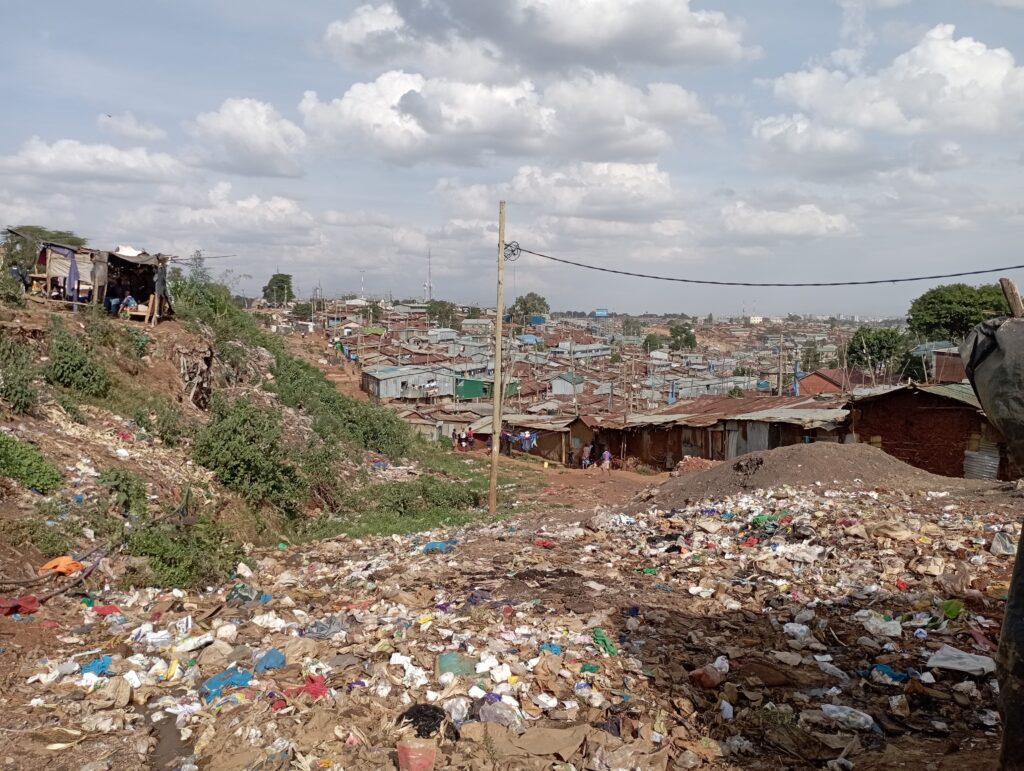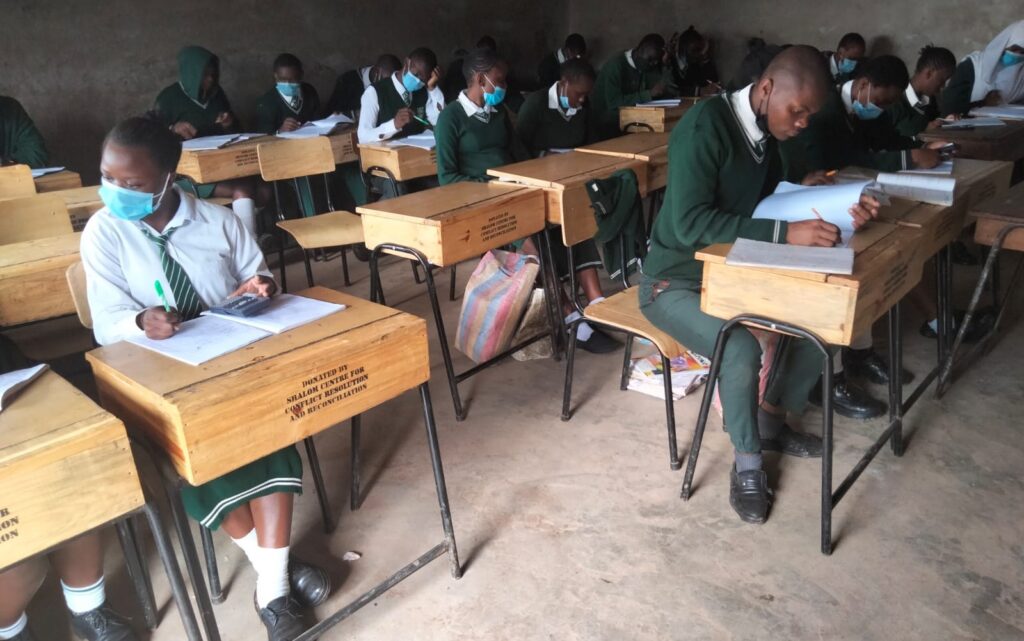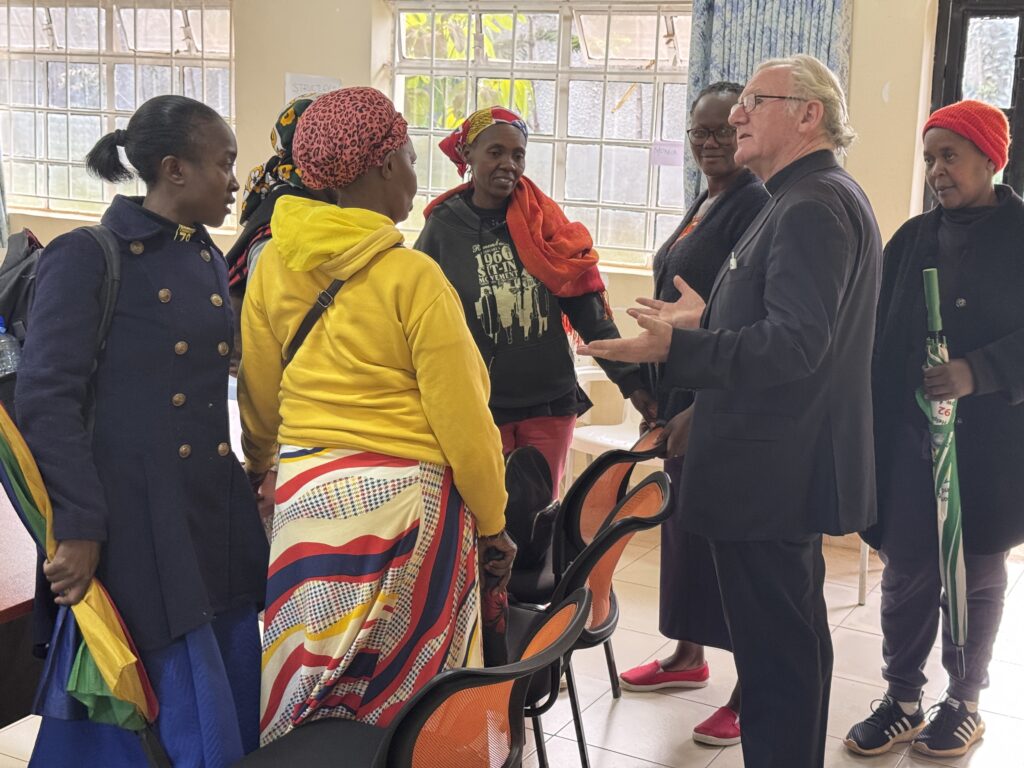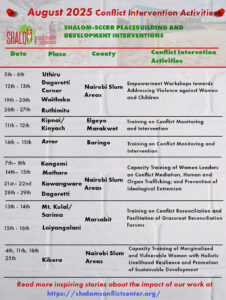Kibera, located in Nairobi, Kenya, and often cited as Africa’s largest slum, is a complex socio-political ecosystem riddled with historical marginalization, systemic poverty, and intermittent violence. Divided into five major administrative wards; Woodley, Makina, Laini Saba, Lindi and Sarang’ombe, communities living in Kibera suffer mainly from insecurity, issues with the existing land tenure system and fierce competition over structural ownerships in lieu of the current affordable housing project in the area. Despite its unique culture, difficulties and resilient population, Kibera remains emblematic of structural violence and chronic socio-economic exclusion. These realities continue to fuel structural violence and physical conflict, making the need for informed and strategic conflict intervention all the more urgent.

In this context, the conflict negotiation strategy employed by the Shalom Center for Conflict Resolution and Reconciliation (Shalom-SCCRR) offers a viable pathway toward positive peace, conflict transformation and eventually social transformation. Shalom-SCCRR’s transformative interventions stand out for their unique, globally acknowledged and acclaimed methodology, which amalgamates rigorous conflict analysis, conflict sensitivity, and evidence-based peacebuilding strategies. This encompasses jointly-agreed and negotiated interventions that yield peace dividends in mutually beneficial interethnic institutions such as schools and health facilities. Driven by a team of highly skilled and dedicated professionals, Shalom-SCCRR works not only within the complex socio-economic realities of impoverished urban informal settlements (slums) but also across the challenging and often overlooked semi-arid remote terrains of Eastern Africa. By tailoring interventions to address the root causes of conflict while fostering reconciliation, Shalom-SCCRR continues to consistently bridge divides, strengthen community resilience and create lasting pathways toward positive peace and sustainable development in diverse and high-need contexts.
By empowering local communities as well as other key stakeholders to engage in constructive engagements which address the root causes of conflict, these strategies have shown promise in similar settings across Eastern Africa. For instance, in Mathare (one of Nairobi’s oldest slums), structured and facilitated community forums at the grassroots between youth groups, elders and law enforcement are being used as an intervention strategy to mitigate gang-related violence and improve relations between the community and the police. The successes gained from this strategy highlight the fact that when local voices are included and root causes are directly addressed, sustainable peace becomes far more achievable.
Kibera’s history is inextricably linked to inter-ethnic tensions, political manipulation, and urbanization neglect. Lacking official land tenure, residents face insecure housing, inadequate infrastructure, and minimal access to public services. These conditions reflect structural violence—a form of violence wherein human beings are influenced so that their somatic and mental realizations are below their potential realizations (Galtung, 1969). That is, people cannot meet their basic and ontological human needs. The fulfilment of these needs is essential if conflict is to be avoided at the community, ethnic, national and international levels (Burton, 1997).
Marginalization is another defining feature of Kibera’s reality. Residents are predominantly excluded from meaningful participation in governance, development planning, and political decision-making. This sense of disenfranchisement breeds resentment and mistrust toward state institutions, contributing to cycles of grievance and instability.

During national elections, Kibera often becomes a hotspot for political violence involving killings, maiming, displacements and other forms of woundedness, fueled by ethnic loyalties, youth unemployment and manipulative politics. Inter-ethnic violence and competition for scarce resources, especially water, land, and employment which regularly ignite tensions.
Shalom-SCCRR’s approach to conflict negotiation—grounded in rigorous quantitative empirical research, community engagement, and collaborative negotiated/mediated problem-solving—offers an agile and adaptable framework for resolving entrenched conflicts in Kibera. Conflict negotiation, as distinct from mere mediation or arbitration, emphasizes mutual understanding, active listening and the co-creation of mutually acceptable solutions between conflicting parties.
This method aligns with Shalom-SCCRR’s mission to not only identify but transform the deeply-rooted underlying causes that drive conflict. Rather than merely responding to surface symptoms, Shalom-SCCRR’s methodology employs various interventions such as conflict negotiation/mediation, amongst others, to effectively respond to the structural causes of conflict, those being, identity-based issues, historical injustices, marginalization, and inequity. Based on Shalom-SCCRR’s comprehensive and collaborative peacebuilding approach, applying this intervention in Kibera entails a community-led process informed by local realities. Some practical steps include, but not limited to:
1. Community Forums
Bringing together key influential opinion shapers such as local elders, youth leaders, women leaders, religious leaders, and local administrative leaders.
Facilitating structured engagements using neutral facilitators trained by Shalom-SCCRR known as Community Facilitators (CFs).
Encouraging the identification of shared challenges such as insecurity, lack of clean water, unequal distribution of water, youth unemployment and/or ethnic or political divisions.

2. Capacity Building Workshops
Training community members in Conflict Negotiation while taking into consideration conflict sensitivity due to the sensitive nature of the root underlying causes.
Empowering the most vulnerable community groups with alternative livelihood resilience skills to divert them from violent mobilization and susceptibility.

3. Conflict Early Warning and Early Response Systems
Establishing local community structures to monitor signs of escalating tension, particularly during election seasons/periods.
4. Community Action Planning
Supporting community development projects that promote cooperation and inter-ethnic solidarity and cohesion such school/educational development programs.

Through its systematic approach and application to grassroots peacebuilding, Shalom-SCCRR aims to yield several positive outcomes such as:
• Reduction in Cyclical Violence: Addressing the triggers, proximate and structural (root) causes reduces the likelihood of recurrent clashes, especially around elections.
• Improved Inter-ethnic Relations: Enhanced trust and communication between the different ethnic and political groups.
• Empowered Local Leadership: Community leaders become custodians of peace rather than passive observers.
• Policy Inclusion: Community-generated solutions can influence county and national development policies.
• Resilience against Political Manipulation: A more informed and united community is less vulnerable to incitement and propaganda.
• Generate Social Progress and Development Outreach: Strengthening the capacity of the community to initiate and safeguard community development projects for sustainable peace and development.
Kibera’s challenges are a microcosm of broader socio-political and economic injustices, deeply entrenched in Kenya’s urban development and governance systems. Yet, within its struggles lie opportunities for resilience and transformation. The conflict negotiation model advocated for and trained by Shalom-SCCRR offers a pathway not only to peace but to justice—by equipping the people of Kibera with the necessary tools and techniques for them to be architects of their own inter-dependent future of coexistence in a safer and more developed environment.
By focusing on encouraging communication, local ownership, and structural change, conflict negotiation does more than prevent violence—it cultivates the conditions for inclusive and sustainable peace and development particularly to education.

Shalom-SCCRR goes beyond capacity-building initiatives in urban informal settlements (slums) such as Kibera by integrating comprehensive educational development programs into its peacebuilding framework. Recognizing that education is a vital pillar for sustainable peace and social transformation, Shalom-SCCRR has actively developed and supported over 40 marginalized schools, positively impacting more than 20,000 learners over the past decade within Nairobi’s informal settlements, through the provision of essential learning materials, infrastructural improvements, and teacher empowerment initiatives. These school/educational development interventions not only enhance the quality of education but also create safer, more inclusive learning environments for children—many of whom face the daily realities of poverty, insecurity, and limited opportunities. By investing in education alongside community capacity building, Shalom-SCCRR empowers the next generation of peacebuilders while addressing the structural inequalities that often fuel conflict in marginalized urban areas.


Shalom-SCCRR’s unique and holistic approach, supplemented by its qualified team members, who are experts in matters of conflict management, peace and development, have proven both crucial and successful in its intervention strategies in many of its conflict transformation project areas.

Be that as it may, the road towards full conflict transformation between and among communities living not just in Kibera, but also other urban informal settlements/slums, still poses challenges such as, but not limited to, availability of resources, lack of robust and functional institutions, education, medicine, inter-alia, law and order as well as the issue of political economy generating the persistence of conflict.
With your donor support, Shalom-SCCRR will not only intensify their intervention strategies within the conflict-affected and marginalized communities but also further reach out to other communities located in emerging or new conflict areas.
Author: Moses Osiro, MA, Shalom-SCCRR Project Officer, Nairobi Project.
Relevant Links
- Shalom-SCCRR. (2025). 2024 Conflict Transformation & Peacebuilding Results and Achievements. https://shalomconflictcenter.org/2024-conflict-transformation-peacebuilding-results-and-achievements/
- Shalom-SCCRR. (2025, June 4). Shalom-SCCRR 15 Years Results and Achievements. https://shalomconflictcenter.org/shalom-sccrr-15-years-results-and-achievements/
- Devine, P.R. (2025, May 9). Shalom-SCCRR Chairman’s Report for 2024; Rev. Dr. Patrick Devine. https://shalomconflictcenter.org/shalom-sccrr-chairmans-report-for-2024-rev-dr-patrick-devine/
- Shalom-SCCRR. (2025). School/Educational Development Results and Achievements. https://shalomconflictcenter.org/school-educational-development-results-and-achievements/
- Shalom-SCCRR. (2025). Shalom-SCCRR 2024 Results. https://shalomconflictcenter.org/shalom-sccrr-2024-results/
- Otsieno, J. (2020). Briefing Paper No 1: A Conflict Analysis of Nairobi’s Informal Settlements. https://shalomconflictcenter.org/briefing-paper-no-1/
- Otsieno, J. (2024). Nairobi Slums’ Structures for Conflict Transformation: Shalom-SCCRR Trained Negotiation and Community Facilitators (CFs) Continue to Initiate Village /Ward Level Forums for their Leaders to Negotiate Communal Conflicts. https://shalomconflictcenter.org/nairobi-slums-structures-for-conflict-transformation-shalom-sccrr-trained-negotiation-and-community-facilitators-cfs-continue-to-initiate-village-ward-level-forums-for-their-leaders-to-negotiate-commu/
- Kibe, E, Salah, I. A. & Osiro, M. (2023). The Informal Settlements (Slums) of Nairobi; Shalom-SCCRR Enhancing Women’s Capacity in Conflict Transformation and Peacebuilding. https://shalomconflictcenter.org/the-informal-settlements-slums-of-nairobi-shalom-sccrr-enhancing-womens-capacity-in-conflict-transformation-and-peacebuilding/
- Otsieno, J., Kibe, E. & Osiro, M. (2023). Shalom-SCCRR Peace Education in violent and deprived locations: Interventions within Schools in Kenya’s Urban Informal Settlements (Slums) of Kibera, Mathare, and Kariobangi. https://shalomconflictcenter.org/shalom-sccrr-peace-education-in-violent-and-deprived-locations-interventions-within-schools-in-kenyas-urban-informal-settlements-slums-of-kibera-mathare-and-kariobangi/
- Otsieno, J. (2020). Thousands of Children and Families in Nairobi’s Korogocho Slum Benefit from Shalom-SCCRR Transforming Interventions. https://shalomconflictcenter.org/thousands-of-children-and-families-in-nairobis-korogocho-slum-benefit-from-shalom-sccrr-transforming-interventions/
- Butler, J. (2023). Harvard Kennedy School; A Conversation with Rev. Dr. Patrick Devine and Paula Soumaya Domit. https://shalomconflictcenter.org/wp-content/uploads/2024/01/Harvard_Kennedy_School_Article_WITH_PHOTOS_MAP_1_17_24_FINAL.pd
- Shalom-SCCRR. (2022). Shalom Empowerment Center (SEC) Addressing Violence against Women and Children: Concept Document. https://shalomconflictcenter.org/eastern-africa-shalom-empowerment-center-sec-addressing-violence-against-women-and-children-concept-document/
- Otsieno, J. & Kibe, E. (2022). Shalom Empowerment Center (SEC) Addressing Violence against Women and Children: A Unique Shalom-SCCRR Initiative Opened. https://shalomconflictcenter.org/shalom-empowerment-center-sec-addressing-violence-against-women-and-children-a-unique-shalom-sccrr-initiative-opened/
- Domit, P. S. & Devine, P. (2024). Shalom Center for Conflict Resolution and Reconciliation (SCCRR): Addressing the Violence of Human and Organ Trafficking. https://shalomconflictcenter.org/shalom-center-for-conflict-resolution-and-reconciliation-sccrr-addressing-the-violence-of-human-and-organ-trafficking/
- Nyambura, J. (2024). Combating Human and Organ Trafficking: Shalom-SCCRR’s Step towards Protecting Vulnerable Lives. https://shalomconflictcenter.org/combating-human-and-organ-trafficking-shalom-sccrrs-step-towards-protecting-vulnerable-lives/
- Devine, Patrick R. (2025). Conflict and Religion in Eastern Africa: A Conceptual Consideration of Radicalisation, Fundamentalism, Extremism, Terrorism, Tolerance, and Their Interaction Dynamics. https://shalomconflictcenter.org/wp-content/uploads/2025/07/Patrick-Devine-Tangaza-Journal-Conflict-and-Religion-in-Eastern-Africa-Jun-2025.pdf
- Okoth, G. & Mwangi, F. (2022). Shalom-SCCRR Facilitates at AMECEA Forum on Addressing Religious Ideological Extremism in Eastern Africa. https://shalomconflictcenter.org/shalom-sccrr-facilitates-amecea-forum-on-addressing-religious-ideological-extremism-in-eastern-africa/
- Devine, P. R. (2017). “Radicalization and Extremism in Eastern Africa; Dynamics and Drivers”, published in the Journal of Mediation and Applied Conflict Analysis, 4 (2). http://mural.maynoothuniversity.ie/9086/7/PD-Radicalisation-2017.pdf


